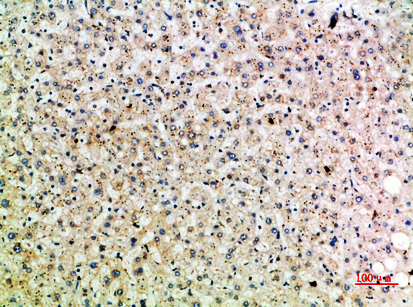TRAP1 antibody
GTX102017
ApplicationsImmunoFluorescence, Western Blot, ImmunoCytoChemistry, ImmunoHistoChemistry, ImmunoHistoChemistry Paraffin, Other Application
Product group Antibodies
TargetTRAP1
Overview
- SupplierGeneTex
- Product NameTRAP1 antibody
- Delivery Days Customer9
- Application Supplier NoteWB: 1:500-1:3000. ICC/IF: 1:100-1:1000. IHC-P: 1:100-1:1000. *Optimal dilutions/concentrations should be determined by the researcher.Not tested in other applications.
- ApplicationsImmunoFluorescence, Western Blot, ImmunoCytoChemistry, ImmunoHistoChemistry, ImmunoHistoChemistry Paraffin, Other Application
- CertificationResearch Use Only
- ClonalityPolyclonal
- Concentration0.22 mg/ml
- ConjugateUnconjugated
- Gene ID10131
- Target nameTRAP1
- Target descriptionTNF receptor associated protein 1
- Target synonymsHSP 75, HSP75, HSP90L, TRAP-1, heat shock protein 75 kDa, mitochondrial, TNFR-associated protein 1, heat shock protein family C member 5, testicular tissue protein Li 209, tumor necrosis factor type 1 receptor-associated protein
- HostRabbit
- IsotypeIgG
- Protein IDQ12931
- Protein NameHeat shock protein 75 kDa, mitochondrial
- Scientific DescriptionHSP90 proteins are highly conserved molecular chaperones that have key roles in signal transduction, protein folding, protein degradation, and morphologic evolution. HSP90 proteins normally associate with other cochaperones and play important roles in folding newly synthesized proteins or stabilizing and refolding denatured proteins after stress. TRAP1 is a mitochondrial HSP90 protein. Other HSP90 proteins are found in cytosol (see HSP90AA1; MIM 140571) and endoplasmic reticulum (HSP90B1; MIM 191175) (Chen et al., 2005 [PubMed 16269234]).[supplied by OMIM]
- Storage Instruction-20°C or -80°C,2°C to 8°C
- UNSPSC12352203
References
- Avolio R, Agliarulo I, Criscuolo D, et al. Cytosolic and mitochondrial translation elongation are coordinated through the molecular chaperone TRAP1 for the synthesis and import of mitochondrial proteins. Genome Res. 2023,33(8):1242-1257. doi: 10.1101/gr.277755.123Read this paper
- Avolio R, Agliarulo I, Criscuolo D, et al. Cytosolic and mitochondrial translation elongation are coordinated through the molecular chaperone TRAP1 for the synthesis and import of mitochondrial proteins. bioRxiv. 2023,:pii: 2023.01.19.524708. doi: 10.1101/2023.01.19.524708.Read this paper
- Matassa DS, Criscuolo D, Avolio R, et al. Regulation of mitochondrial complex III activity and assembly by TRAP1 in cancer cells. Cancer Cell Int. 2022,22(1):402. doi: 10.1186/s12935-022-02788-4Read this paper
- Chen JH, Wu CH, Jheng JR, et al. The down-regulation of XBP1, an unfolded protein response effector, promotes acute kidney injury to chronic kidney disease transition. J Biomed Sci. 2022,29(1):46. doi: 10.1186/s12929-022-00828-9Read this paper
- Lee Y, Fong SY, Shon J, et al. Time-of-day specificity of anticancer drugs may be mediated by circadian regulation of the cell cycle. Sci Adv. 2021,7(7). doi: 10.1126/sciadv.abd2645Read this paper
- Lanzillotta C, Zuliani I, Tramutola A, et al. Chronic PERK induction promotes Alzheimer-like neuropathology in Down syndrome: Insights for therapeutic intervention. Prog Neurobiol. 2021,196:101892. doi: 10.1016/j.pneurobio.2020.101892Read this paper
- Zhao X, Sun K, Lan Z, et al. Tenofovir and adefovir down-regulate mitochondrial chaperone TRAP1 and succinate dehydrogenase subunit B to metabolically reprogram glucose metabolism and induce nephrotoxicity. Sci Rep. 2017,7:46344. doi: 10.1038/srep46344Read this paper
- Brauers E, Roos A, Kollipara L, et al. The Caveolin-3 G56S sequence variant of unknown significance: Muscle biopsy findings and functional cell biological analysis. Proteomics Clin Appl. 2017,11(1-2). doi: 10.1002/prca.201600007Read this paper



![IHC-P analysis of human liver tissue using GTX16195 TRAP1 antibody [TRAP1-6]. Left : Primary antibody Right : Negative control without primary antibody Antigen retrieval : heat induced antigen retrieval was performed using 10mM sodium citrate (pH6.0) buffer, microwaved for 8-15 minutes Dilution : 1:20](https://www.genetex.com/upload/website/prouct_img/normal/GTX16195/GTX16195_1051_IHC-P_w_23060620_943.webp)

